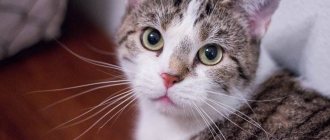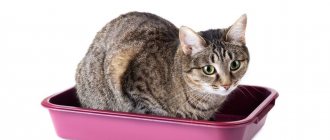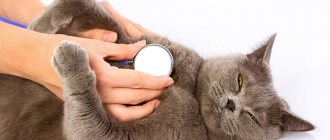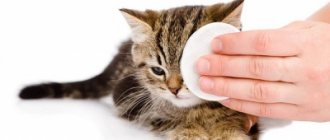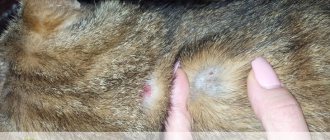Visitors to veterinary clinics, complaining about a cat’s illness, use the word “choking” to mean both true suffocation and short, intermittent, frequent breathing of the animal with an open mouth. Such problems are more common among dogs; they occur much less frequently in cats. If a cat breathes like a dog, this is not the norm.
They say that a cat is suffocating if the animal sits in an unnatural position, the breathing movements are short, intermittent, frequent, and sometimes the cat sticks out its tongue. Choking develops if the airways are mechanically blocked by swollen tissue, liquid or a foreign object.
Signs of rhinotracheitis in cats
Symptoms of rhinotracheitis appear gradually. On average, the incubation period ranges from 3 to 8 days. Often, sick animals experience an increase in temperature up to 40°C (we remind you that a cat’s normal body temperature varies from 37.5 to 39°C).
Rhinotracheitis in cats occurs in acute or chronic form. In the second case, prolonged remission alternates with bouts of relapse. 80% of animals after recovery are carriers of the virus.
Read also: Location table rules of war 2021
The main signs of rhinotracheitis in cats:
- purulent discharge from the eyes and nose,
- conjunctivitis,
- inflammation of the nasal mucosa,
- cough,
- small ulcers on the tongue,
- profuse drooling,
- dyspnea,
- deterioration or complete loss of appetite,
- weight loss,
- general weakness,
- sluggish, apathetic state.
Do you suspect your cat has rhinotracheitis? Do not hesitate - go to a veterinary clinic and get examined. If you seek help in a timely manner and receive effective treatment, your pet’s recovery will take about 8-10 days.
Signs of asthma: what should the owner pay attention to?
The first thing that indicates asthma in a cat is a cough. At the same time, furry pets bend their paws and stretch their necks. The cough is quite strong and protracted, reminiscent of regurgitation of fur, so some owners ignore this symptom, attributing it to the animal’s normal behavior.
Symptoms of bronchial asthma in a cat:
- sudden coughing fits of varying duration,
- dyspnea,
- labored breathing,
- wheezing,
- fast fatiguability,
- lethargy,
- refusal of games and activities,
- loss of appetite.
In severe cases of asthma, oxygen deficiency (hypoxia) occurs. The level of oxygen in the body decreases, and the mucous membranes turn blue - cyanosis develops. In this case, immediate veterinary attention is required.
Diagnostics
Having studied the external symptoms of cough, we proceed to diagnosis:
- conduct an external examination of the body, listen for wheezing and noises;
- evaluate cardiac activity;
- take blood for analysis;
- do an X-ray examination of the sternum;
- a culture of secretions or sputum is collected to identify the causative agent of inflammation;
- examine the affected organ for oncology (if suspected).
In clinics, it is possible to examine the entire animal’s body by different specialists and conduct an X-ray examination with a contrast agent.
How to provide first aid to a choking pet
First aid methods depend on the cause of the illness. In case of short-term disturbance, breathing often normalizes on its own, but in case of long-term disturbance, followed by cardiac arrest, the animal may require artificial respiration and indirect massage.
Basic steps
For physiological reasons, the pet simply needs to be given time to catch its breath and calm down. If overheating is to blame, be sure to offer a bowl of water and cool the areas where large vessels pass (neck, inner thighs, groin) with a cold compress. It is also recommended to open all doors and windows to create a draft.
If the cat is breathing heavily and wheezing, carefully examine his throat and check the integrity of the ribs. If you find a foreign body or injury, go to the veterinary clinic immediately. Self-help can result in accidentally pushing the found bone or other object even deeper, so it’s better not to take risks here.
Thus, the main actions are limited to normalizing body temperature, ventilating the room and calming the animal. The only exception is sudden cardiac arrest, as well as poisoning, provided its cause is known.
Is it possible to do artificial respiration?
If a cat loses consciousness and does not respond to light, then it requires urgent resuscitation. The rescue operation must begin within 2-3 minutes after the heart has stopped. In such a critical situation, it is very important not to panic, immediately call a veterinarian at home, and then strictly follow the following algorithm:
- Place the animal on its right side and extend its neck in line with the body. This will facilitate air flow.
- Clean the oral cavity from accumulated secretions with a napkin or gauze and close the mouth tightly. Removing mucus will help your pet avoid choking once breathing returns to normal.
- Inhale more air, place your curled palm on the cat’s nose and gently exhale into his nostrils. The frequency of inhalations depends on the size of the animal. With average settings, 20 times per minute is enough. The kitten will need more frequent but less intense repetitions.
- Check your pulse every 20 seconds. When breathing stops, the heart temporarily continues its work, so indirect massage is not required in all cases. If the heartbeat has really stopped, move on to the next step.
- Place one hand on the cat's chest, holding it between the thumb and the other four fingers.
- Perform several quick and rhythmic pressing movements with a break of 5 seconds, remembering to alternate them with artificial respiration. For every 30 movements there should be 2 breaths.
If possible, the rescue operation is best carried out in pairs. Once the heartbeat resumes, the animal cannot be moved, so at this point you just need to wait for the veterinarian.
First aid
In addition to the above private signs, the cat owner’s anxiety and concern should be caused by the following symptoms, common to all conditions that threaten the pet’s life:
- the cat is apathetic and lethargic;
- frequent vomiting;
- cough is dry or with bloody sputum;
- the cat shows signs of anxiety and fear.
If these symptoms are present in addition to difficulty breathing, the most effective help for your pet will be to take him to the clinic as soon as possible or call a doctor at home. During transportation or while waiting for help, the cat should be placed on its side and, if possible, its mobility should be limited.
It should be remembered that you cannot hesitate and waste time. Prolonged hypoxia entails irreversible changes in the brain, which will lead to the death of the pet.
Disease prevention
It will not be possible to achieve a complete recovery of an animal with asthma, so your main task as the owner is to protect the pet from possible attacks of prolonged coughing. To do this, just follow simple recommendations from experienced veterinarians:
- carry out wet cleaning frequently,
- ventilate the rooms regularly,
- do not allow dust to accumulate,
- think about choosing a humidifier,
- use powders and other household products from the “Eco” category,
- carefully monitor your pet's diet,
- move house flowers and plants to the balcony - if possible,
- do not smoke indoors,
- choose non-dusty litter for the tray.
Remember that the life and health of your pet is in your hands!
Heart problems
Many people do not know what to do if a cat coughs and wheezes, for what reason this reflex occurs. A serious reason to see a doctor is the occurrence of heart problems. Most often, this disease occurs in old and overweight animals. At first, coughing rarely bothers the animal, but later it inevitably becomes more frequent.
The disease is diagnosed by tactile and visual examination. The pet's blood pressure is measured, electrocardiography and radiography are performed. Such a disease requires lifelong care for the animal and maintenance therapy. Treatment is prescribed by a veterinarian based on the research results obtained. Giving medications at your own discretion is strictly prohibited.
The cat must be provided with rest, proper nutrition and follow the doctor's instructions. For animals with this pathology, special dietary foods are sold in pharmacies.
Why is a cat breathing heavily and frequently: non-dangerous reasons
Tachypnea, or rapid, heavy breathing, occurs in a cat when there is a lack of oxygen, or hypoxia. This condition is explained by 2 reasons: physiological and pathological.
Physiological causes are not life-threatening. These include various external and internal factors:
- Heat. A pet can overheat outside on a hot day or in a stuffy room with poor ventilation.
- Eating food quickly. Characteristic in the absence of saturation and prolonged fasting. Due to the too rapid absorption of food, breaths are taken in fits and starts, so the oxygen supplied with them is not enough.
- Fatigue after high physical activity. When performing intense movements, muscles require more oxygen, which is why shortness of breath often occurs while running.
- Overexcitement due to fear or aggression. In a state of stress, the body actively produces adrenaline, which speeds up the heart and the frequency of breathing. After calming down, the alarming symptoms disappear on their own.
- Hormonal changes. Occurs during estrus, pregnancy and childbirth. Treatment in these cases is not required, provided that the rest of the condition remains normal.
The risk group includes older cats and overweight cats. They get tired faster and often suffer from obesity due to inactivity.
What is this?
Respiratory failure (RF) in dogs and cats is a pathological condition in which the animal’s lungs do not provide normal blood gas composition or do, but it is achieved due to the intensive work of the external respiratory apparatus and heart, which reduces the functional characteristics of the body.
Important! Pulmonary insufficiency in cats and dogs is dangerous because without timely treatment it leads to acute and chronic diseases of the bronchopulmonary system, circulatory disorders, damage to the central nervous system and a number of other dangerous complications.
Causes of wheezing
There are many factors why a cat coughs. Among the main ones are allergic reactions, foreign bodies in the respiratory tract, bronchial asthma, helminths, inflammatory processes in the lungs, viruses and heart disease.
An allergic reaction in a cat occurs when an irritant enters the respiratory tract. Allergies can be caused by household dust, chemicals (detergents, aerosols, tray fillers), low-quality dry food and chemicals used for repairs.
Some cats suffer from allergies caused by seasonal flowering plants. Cough also occurs in cats whose owners smoke. When the animal breathes, gurgling and wheezing sounds can be heard.
Another cause of coughing in a cat is foreign objects stuck in the throat or nasal passages. These can be small bones and objects, as well as trichobezoars (balls of hair). In this case, the cat coughs and wheezes, trying to clear its throat and get rid of the irritating object.
Bronchial asthma is a dangerous condition of the animal’s body, the symptom of which is a strong, lingering cough and a general deterioration in the pet’s condition. Asthma is often associated with a genetic predisposition and can occur as a result of common allergies.
Cough can also be caused by helminthiasis. This is one of the most commonly diagnosed causes of animal cough.
Cat owners mistakenly believe that parasites exclusively affect the intestinal tract. In fact, lungworms are much more dangerous and often fatal, affecting the animal's respiratory system.
During breathing, the cat can hear wheezing, provoked by increased mucus production to quickly get rid of cysthelminths.
Pneumonia is a disease that affects the lower parts of the respiratory system. It usually occurs against the background of bacterial and viral infections of the respiratory tract, rarely developing independently. In addition to coughing, the animal experiences breathing disturbances, a large amount of sputum and mucus produced, a deterioration in the animal’s general condition and an increase in body temperature.
The cause of a specific reaction of the body in the form of a cough can be all kinds of viral infections that affect the nose, pharynx, bronchial tree and lungs. The most dangerous are viral rhinotracheitis and calcivirosis. In addition to coughing, the cat is diagnosed with apathy, depression of general condition and refusal to eat. Viral infections are often accompanied by an increase in body temperature to high levels.
Diseases of the heart muscle that provoke coughing are rarely diagnosed in domestic cats. If there is a disturbance in the functioning of the heart, the visible mucous membranes become cyanotic, shortness of breath and depression of the general condition are observed.
The owner of a mustachioed pet should carefully monitor the nature and strength of the cough, noting other accompanying symptoms. It is not recommended to self-medicate, since without an accurate diagnosis it is not possible to make a diagnosis and prescribe treatment. Moreover, by delaying a visit to a specialist, the owner only makes things worse. Especially when it comes to foreign bodies stuck in the respiratory tract, because the animal can die.
Stress and psycho-emotional reasons
As a rule, stress and psycho-emotional reasons in cats do not often lead to breathing problems. But this statement is only partly true. There are several breeds of cats that are characterized by an overly emotional disposition and even some odd behavior:
- Persian cats.
- Siamese and crossbred animals based on them.
- “Good-natured giants”, Maine Coons, can be very aggressive.
Some representatives of these breeds are characterized by short-term (and sometimes not very short) outbursts of anger. In this case, the cat may lose control of itself, breathe hoarsely and quickly, and meow loudly and protractedly. Trying to calm him down costs yourself more. If this happens constantly, you need to consult a veterinarian about prescribing sedatives and medications to correct the animal’s behavior.
Types of cough
Just like in humans, a cat’s cough is characterized by several criteria, thus being divided into types:
By duration:
- Chronic – lasts for months;
- acute – lasts several days.
By the nature of the discharge:
- wet;
- dry.
By volume:
- muted;
- weak;
- voiced.
By intensity:
- easy;
- hysterical, leading to vomiting.
By time of day:
- morning;
- evening.
By season:
- spring;
- autumn, etc.
When you observe your pet's cough, try to determine its type based on these parameters, so that you can then provide the doctor with a complete picture of the disease. Also pay attention to the time of day at which the cough peaks.
Helping a cat with choking
If your cat is choking, you should see a veterinarian as soon as possible. If it is not possible to show the animal to a specialist, try to quickly remove the object from the animal’s throat/mouth yourself (except for needles and sharp objects - only a veterinarian can remove them!). Be careful and attentive, as in this state the cat experiences panic and may become aggressive.
Secure your pet and place the index finger and thumb of one hand on his upper lip, pressing it against his jaw. With your other hand, open the cat's mouth. Gently pull on the tongue to examine the throat and mouth. Try removing the foreign object with tweezers. If something is stuck in the throat or esophagus, you can remove it by inducing vomiting in the cat (only if the animal has swallowed a non-sharp object!). Give him a teaspoon of water salted with ¼ teaspoon salt.
Vaseline oil will help you deal with a small foreign object (a blade of grass, a hair): pour 1 teaspoon of this liquid into the cat’s mouth. Vegetable oil can help remove a foreign object or at least move it into the stomach (give the cat 2-3 teaspoons).
If none of the above methods help, try the following: spread your legs wide, turn the cat upside down and shake vigorously. If there is no positive result, place the pet on its side, place your palms on the sides of its body behind the last ribs. Press sharply on the sides with your hands several times - the object should jump out of the animal’s mouth.
Signs of suffocation and foreign objects in the mouth
The following signs may indicate that a cat has a foreign object stuck in its throat:
- persistent cough;
- the cat salivates profusely;
- the pet is choking, suffocating.
If you notice these signs in your cat, check his mouth - there may be a foreign object there. If the pet is not given help, it may die from suffocation, which is accompanied by the following symptoms:
- cough and wheezing;
- the pet's eyes pop out of their sockets;
- the tongue and gums turn blue;
- the animal tries to put its paw into its mouth;
- loss of consciousness.
How to provide help at home?
With rhinotracheitis, cats do not stay in the clinic, but are sent home with the owner. To prevent your pet’s condition from worsening, carefully follow all the veterinarian’s recommendations. Under no circumstances treat a cat’s cough with “human” drugs to thin the sputum - this is very dangerous for the pet’s health.
In cases where a cat's eyes are affected by rhinotracheitis, it is prohibited to use any drops!
At home, it is necessary to provide the animal with:
- drinking plenty of water,
- balanced high-calorie diet,
- a cozy and warm place to relax,
- peace and quiet.
If the cat completely refuses to eat, then contact the veterinarian again - this is necessary to put on an IV and avoid the development of complications.
Is it possible to prevent suffocation?
Eliminating choking hazards helps provide a safe environment for your cat. Walk around the apartment, putting yourself in the shoes of your furry friend, and try to find objects that are interesting from his point of view: something small, shiny and easy to swallow.
Common hazards that can cause choking include:
- goods for creativity (pompoms, chenille wire, etc.);
- elastic bands;
- office staples and paper clips;
- plastic bags;
- wine corks and bottle caps;
- cocktail straws;
- foil.
Cats' curiosity can be heightened when the owner is not at home, so it is important to keep things that are dangerous to the animal out of reach. You should not allow your pet to use garbage, such as crumpled foil or cellophane, for entertainment. Of course, playing with these objects gives the cat pleasure, but it only takes a few seconds for them to get stuck in her throat.
When should I worry?
Your cat's wheezing breathing is nothing to worry about. However, it is important to consult a veterinarian to determine the cause of this condition and provide treatment if necessary.
If you see any of the following symptoms along with wheezing, contact your veterinarian immediately.
- Having difficulty catching my breath
- Cough or choking
- Very pale or bluish gums
- Dripping/collection of mucus in the mouth
- Signs of distress (asthma attack)
- Prolonged wheezing
- Very lethargic
Diagnosis of respiratory organs
Diagnostic methods in the clinic are aimed at identifying the causes of choking, coughing and shortness of breath and consist of:
- collecting anamnesis (finding out medical history). At this moment, the main role is assigned to the cat's owner. It is he who must tell about the signs, frequency, rhythm, strength of cough and shortness of breath, how long ago the first case was recorded, whether there is discharge and what other signs were recorded in the animal; • examination and palpation (oral and nasal cavity, trachea and esophagus, thoracic cells for integrity);
- auscultation (listening) of the bronchi and lungs;
- thermometry;
- if necessary, chest X-ray examination;
- performing endoscopy of the trachea;
- carrying out bacterial culture of nasal secretions for subtitration of microflora sensitivity to antibiotics;
- general blood analysis;
- blood chemistry;
- ultrasound examination of the chest cavity;
- analysis of fecal matter for worm eggs;
- thoracentesis (taking the contents of the chest cavity for examination).
Of all the listed diagnostic methods at home, you can carry out inspection, palpation, thermometry and auscultation. Often these methods are not sufficient to establish a diagnosis and prescribe treatment.
How to treat wheezing breathing
Breathing with wheezing in a cat is treated in various ways and means. Depending on the type of disease, the doctor prescribes appropriate treatment.
Laryngeal edema is treated with medications that relieve swelling;
- — Brachiocephalic syndrome is usually eliminated surgically;
- — Pulmonary edema is relieved by intensive therapy, often requiring artificial ventilation;
- — Bronchitis is removed with antitussives;
- — Neoplasms and tumors are eliminated by chemotherapy (if amenable);
- — Foreign bodies are usually removed using an endoscope;
- — Laryngeal paralysis is eliminated through surgery.
The results of treatment if you go to the clinic in a timely manner are mostly positive.
Therapeutic techniques
In the clinic, after clearing the airways, the veterinarian can start breathing using artificial respiration, inserting an endotracheal tube and connecting to a ventilator. An indirect cardiac massage, a defibrillator and injections of drugs (adrenaline, atropine, atipemazole, etc.) help a specialist to start a stopped heart. Depending on the results of resuscitation efforts, studies are prescribed to establish a diagnosis, treatment and further care.
Regular preventive examinations and tests will help identify diseases in the early stages, without leading them to a chronic form. If you have congenital or chronic diseases, you should follow your veterinarian's recommendations for caring for your cat. An attentive and caring owner will always notice suspicious symptoms and seek advice from a specialist, because the life and health of the cat is in his hands.
Tags
if a cat coughs a panting cat in a cat licking fur, this is a cat before If a cat is not an adult cat can If a cat is in a hurry about a dog about a dog Dog breeds Dog health Dog nutrition Dog training Dog health behind a dog Why is a dog afraid of Dogs in cats. cat deaths occur in cats and Cat breeds Cat health Cat nutrition Cat behavior Health cats in cats and in cats and
dogbreedrodentsarticlerespiratoryservicesopen questioncontentsurgeonanswervaccinationbirddepartment
